Trout Lines: Extended Article
I will discuss the best fishing line for trout fishing and why I and other trout guides only use premium fishing lines. I will also discuss the best sizes and types of fishing lines for different methods and when fishing trout in rivers and lakes.
My Quick Pick Best Fishing Lines:
- Sufix Elite – Best Monofilament: This is the best monofilament line for lures and bait fishing for trout fishing on small streams and ponds, I use 6 pound. For bigger lakes, fast rivers, or large trout, upsize to 8-pound line.
- Raven Mainline – Best For Float Fishing: The best line for float fishing is the Raven Mainline because it is more buoyant and lightweight when compared to other lines.
- Sufix 832 – Best All Purpose Trout Line: Baided line like the Sufix 832 is great for casting lures and for bait fishing as long as you use a fluorocarbon leader. many anglers prefer it over mono.
- Seaguar Tatsu – Best Fluorocarbon: The Seaguar TATSU Spinning Line is my favorite fluorocarbon line for spinning reels and I use it only for lures and drift fishing.
These are the lines I use the most. They all have pros and cons and you should know which lines are best for different methods.
We may make a small commission from some of the links on this website, which is at no cost to you. I appreciate your support.
The 3 Best Trout Lines
The three best trout lines are Monofilament, Fluorocarbon, and Braided lines, and each one has advantages and disadvantages depending on the type of water you are fishing and the type of method that you are using.
- Braided Line: I use it a lot on the fishing reels that I use for casting lures in lakes or rivers. I will also use this for float fishing. I like to use braided lines for a number of reasons which I will discuss below.
- Fluorocarbon Line: Many skilled anglers and guides will prefer a quality fluorocarbon line when casting lures in rivers or when using methods like Drift Fishing or bottom bouncing.
- Monofilament Line: The most popular line due to price and becuase it’s been around longer than other types of line. It’s still a good all-purpose line. I mostly use it when I am float fishing for trout in rivers, I only use premium monofilament lines and avoid the cheap stuff.
Is Mono The Best Line For Trout Fishing?
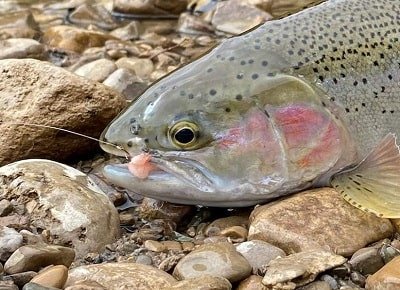
The monofilament line is the most used fishing line by trout anglers. Mono is the most used line because the monofilament line works well with most methods used for trout fishing, making it the most versatile and easy to use.
When I use a mono line for trout fishing with both bait and with lures, I find that it always works best with a good fluorocarbon leader setup.
The major benefits of mono are:
- It is sold everywhere
- It works well on all reels
- It works well with all trout fishing methods
- It also comes in many colors (see below which is best)
- It comes in all the needed sizes for fishing trout
- It’s the least expensive of all the fishing lines
The Best Monofilament Lines For Trout Fishing
You must use a good monofilament line for trout fishing if you want to be able to fish well with mono.
The best monofilament lines for trout fishing are premium lines or what I call performance lines, and I will discuss the advantages of these lines and the disadvantages of the cheap lines.
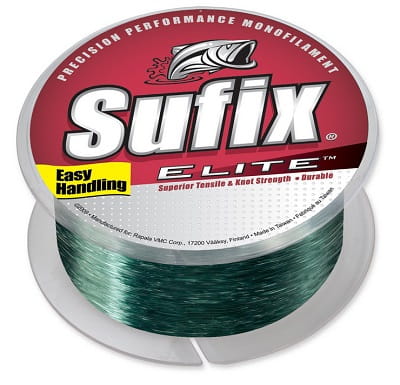
Sufix Elite
This is my favorite all-around mono line for trout and steelhead fishing with spinning reels.
I know many river anglers and other guides who also really like this line.
The key features are
- Superior strength, handling, and durability
- J7 Micro Resin process
- Slick line for farther casts
- Exclusive G2 precision winding
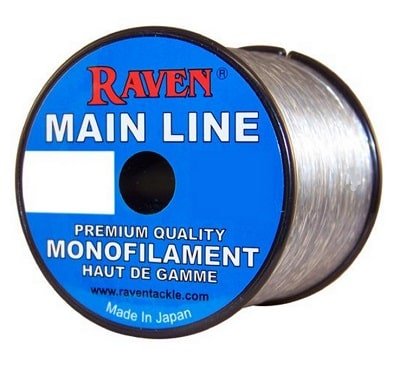
Raven Main Line
This is my favorite line when float fishing for trout. I use it on my spinning reels and on my Centerpin reels.
It’s widely used by other trout anglers and by many fishing guides.
Key Features Are:
- Excellent abrasion resistance
- High breaking strength
- High buoyancy
- Good for float fishing.
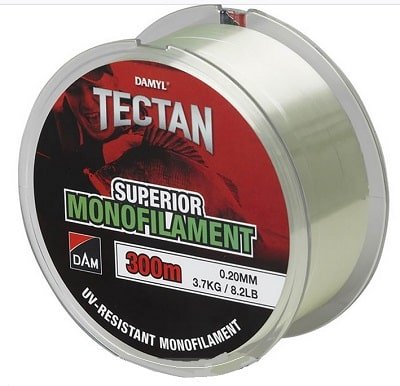
DAM Damyl Tectan
A well-rated line that is very supple with a UV coating to make it last longer.
This is a great line for trout fishing in rivers but is also well-liked by lake anglers.
- UV-protective surface treatment
- Low visibility
- Low memorySuperior abrasion-resistant
- Parallel winding
- Medium elongation
| Species and Size Class | Flourocarbon/Leader | Braided Line | Monofilament | Flourocarbon Mainline |
|---|---|---|---|---|
| Brook trout: 8-20 inches | 2-4 lb test | 8-15 lb test | 6-10 lb test | 6-10 lb test |
| Rainbow trout: 8-20 inches | 2-4 lb test | 8-15 lb test | 6-10 lb test | 6-10 lb test |
| Brown trout: 15-30 inches | 2-8 lb test | 8-15 lb test | 8-15 lb test | 8-15 lb test |
| Steelhead: 20-30 inches | 8-10 lb test | 15-30 lb test | 10-15 lb test | 8-15 lb test |
| Salmon: 20-50 inches | 10-20 lb test | 20-30 lb test | 15-20 lb test | 15-20 lb test |
| Lure Fishing | 8-10 lb test | 15-30 lb test | 10-15 lb test | 8-15 lb test |
One of the disadvantages of mono is that it can have line memory which makes casting difficult.
Line memory creates line coils when it comes off the smaller spinning reel spools and that can affect the way the line goes through the guides and the way it sits on the water. Line memory and line coils can cause problems.
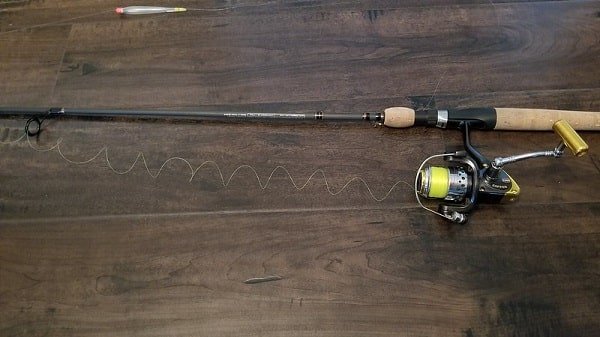
Cheap lines are the worst for line memory and line twist, and that can also cause more tangles and problems, so avoid cheap lines. Cheaper lines that are also thick are even worse.
Good lines like the Suffix Elite line are much better and are lines that I would consider as a performance fishing line or, as they call it, a premium fishing line.
Performance type monofilaments will help you cast better, and they will help you catch more fish when compared to cheap crappy lines because they perform better allowing for better hook sets, stronger knots, and less memory, and they go on the reel better with less line twist.
I find that performance lines can also offer features like being limper or stiffer, or they will be stronger at a thinner diameter which is exactly what you want when you are fishing for line-shy trout.
Some of these performance lines can also have UV coatings to make the lines last longer, some will have less stretch and some are slick for better casting.
GUIDE TIP: Your line and leader are only as good as your knots. Are you using good knots? Check Out: Best Trout Fishing Knots For Beginners That Guides Use.
How To Straighten Fishing Line
Even good fishing lines can have some line memory if left for a long time or if left for too long in the sun or if it’s exposed to heat.
The easiest method to straighten the monofilament fishing line is to stretch it by tying it to something stationary and then walk back about 1.5 times the length you could normally cast and then pull or stretch the line.
Just be careful not to pull too hard or it could break the line near the reel and you will lose a lot of line. This method often works on good-quality lines but not so well on cheap lines.
How Long Does Monofilament Line Last
Monofilament that is stored indoors and out of direct sunlight will last about 3 years. How I test my mono is I will tie my best knot onto a large hook and I will pull it to test how strong the knot is. If it’s hard to break it’s still good, but if it breaks easily, it’s time to recycle it.
Some local tackle shops will take back your old line for recycling.
What Pound Line For Trout
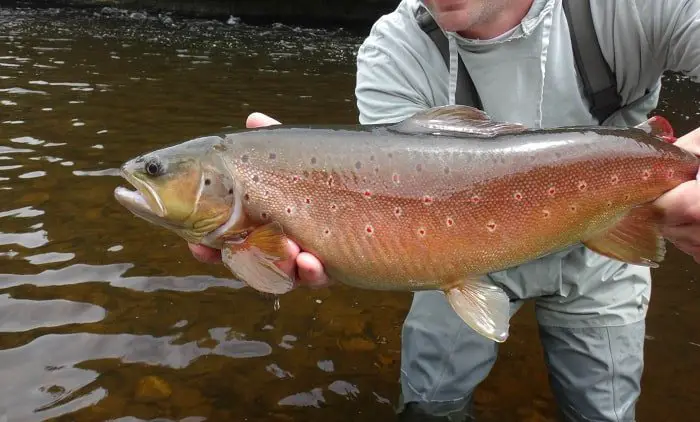
Many of my clients want to know what pound line is best for trout, so this is what I tell them. The right pound line for trout will depend on the size of the water that you fish and the size of the trout you might catch. You will need a different pound line in rivers than you will need in lakes.
What Pound Line For Trout In Rivers
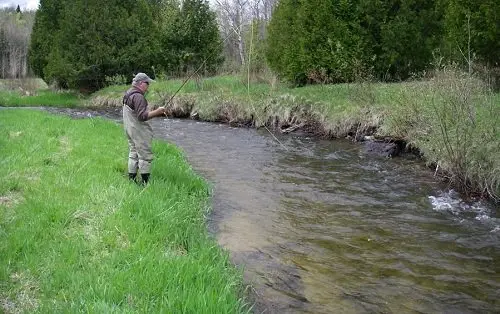
The best pound line for trout fishing in rivers is a 6-pound test which is a good all-around line for bait and for lures. If you are only fishing small creeks, the 4-pound line is best. The 8-pound line is best for trout fishing in big rivers where the trout can use the current to run far.
You can use a lighter line when river fishing because you can often walk up or down the river and the trout really don’t have anywhere to go. On huge rives with big currents, the trout can utilize the current and go far at a fast pace so you will need a heavier line. Just remember your weakest link because a very heavy line might bend hooks or break leaders.
Chances are you will be fishing for line-shy trout and a good fluorocarbon leader that is lighter than your mainline will likely be required. The best pound test for trout when you use leaders will depend on your leader size.
You don’t want to use a 4-pound line with a 6-pound leader. Your mainline, which is the line on your reel, should always be slightly heavier than your leader so the line is more likely to break at the hook instead of up the line somewhere.
When fishing lures in rivers, the key is to get the lure down, have it work properly, and to cover the water well. I discuss all of this in my article, Trout Fishing With Lures.
What lb Test For Trout In Lakes?
When fishing in lakes with lures, you will want an 8-pound line so that you don’t risk losing your lures on big fish that run far.
When lake fishing I prefer to use a braided line with a 3 or 4-pound fluorocarbon leader so the fish don’t see the line. With a braided line, it can be very strong while being 2 to 4 times thinner than a monofilament line. I tend you use a braided line that is around 10 to 20-pound breaking strength but that means it could be as thin as 4 to 6lb mono.
I will discuss braided lines for trout below.
The Best Fluorocarbon Fishing Line For Trout
Fluorocarbon lines are arguably the best fishing lines for trout in rivers for certain methods, and fluorocarbon definitely has its advantages as well as some disadvantages, but the really important thing with fluorocarbon is to buy the right one.
Cheap fluorocarbon lines cause a lot of problems and give fluorocarbon a bad name but it doesn’t need to be that way.
The primary advantage of the fluorocarbon line is that it is the most invisible fishing line to the fish and it’s very abrasion-resistant which can be great if you are fishing around a lot of rocks or logs. It also tends to sink and has less stretch than monofilament, making it the best fishing line for trout.
Since the fluorocarbon line tends to sink, it is good when fishing with lures, but I avoid it and do not recommend it when float fishing which I give reasons for below.
There are many advanced river anglers and river guides that love fluorocarbon lines for lure fishing or when using jigs, or for methods like Drift Fishing or bottom bouncing,
If you do decide to use a fluorocarbon line for trout fishing it is very important to use a high-end fluorocarbon line from a reputable brand. This way you will get a good line that casts well with the type of reel that you use.
The downside to fluorocarbon is that it can be stiff and it can cause problems on spinning reels, and because of that I usually do not usually recommend it to beginners or average anglers for their spinning reels.
Some anglers claim some fluorocarbon lines are stiff right out of the package and they have seen it practically jump off the spool of their spinning reels causing all kinds of problems. I have had clients have problems like this and it’s often it’s due to the line being, or they put it on wrong, or it’s just a low-quality fluorocarbon line that is not good for casting.
Another downside is that a high-quality fluorocarbon line can also be 2 to 3 times more expensive than mono lines.
However, some of the high-quality fluorocarbon lines are more supple and are good when using baitcasting reels and spinning reels.
Often, when using a fluorocarbon line, any slack in the cast or after the cast can cause problems on spinning reels.
Best Fluorocarbon
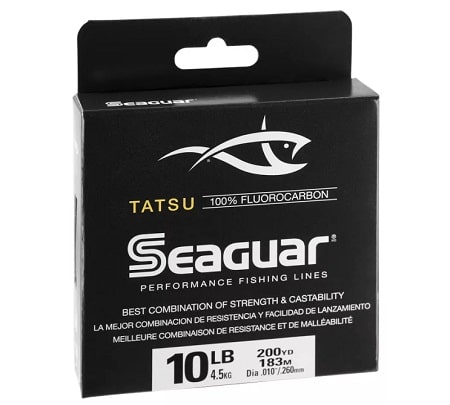
One of the best fluorocarbon lines for baitcasting reels is Seaguar Tatsu Fluorocarbon Line.
The Seaguar company is well known for having the best quality fluorocarbon lines in the world, and they are always a good choice.
The best fluorocarbon lines for spinning reels when fishing for trout are:
- Seaguar Inviz-X fluorocarbon line is one that I have used for many years and is often my go-to line for leaders and for casting lures. This might be the highest-rated fluorocarbon line in the world.
- P-Line Fluorocarbon 100 % Pure Line – The P-line Fluorocarbon is a good line used by trout anglers, and it is one of the highest-rated lines available.
Due to the potential problems and the higher prices, also because it’s less versatile, and because you can easily use a fluorocarbon leader when fishing with monofilament lines, I do not use fluorocarbon as my main line on most of my spinning reels.
I would also never use a fluorocarbon line on any reel that I float fish with because it sinks, and for float fishing, you always want the part of the line above your float to be buoyant when float fishing.
This way, you can mend easier, and you will have less line drag. You will also have a better hookset with a floating line when float fishing.
Braided Fishing Line For Trout
I have also used braided lines when float fishing with spinning reels, baitcasting reels, and even with Centerpin reels, but you must use a good leader setup and know how to properly secure it to the reel.
The Best Braid For Trout
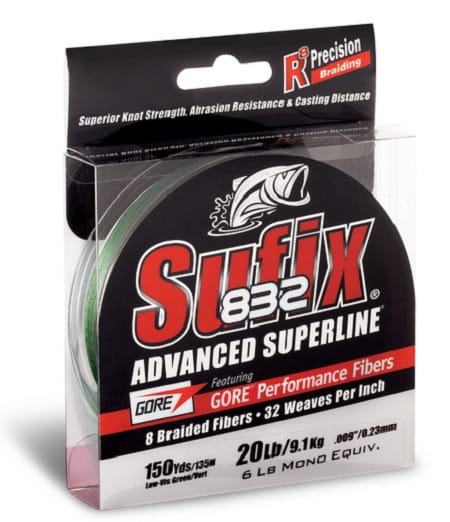
I use braided lines like Sufix 832, Power Pro, SpiderWire, or Fireline on my reels that I only use for casting lures in lakes and rivers.
My new favorite braided line is been Sufix 832 in the dark green color, but before that I was using Powerpro since around 2006.
Expert lure anglers and guides know that when fishing for trout in a river or lake with jagged rocks or with lots of wood and sunken trees, you want to use fluorocarbon and not braid because the braid will cut into the wood, and you’ll get hung up. The sharper rocks can also cut through the braid.
The advantages to using braid when float fishing or bottom bouncing is:
- No stretch, so long hooksets are better
- Most braided lines float, which is great when float fishing
- Braided line has very low or no memory
- Braided line comes off the spool smoothly
- Brained lines are extra strong for their diameter
- Braided lines are more sensitive to help you detect strikes when you are bottom bouncing
The disadvantages of braided lines when float fishing:
- You need a fluorocarbon leader or the trout will see the line.
- Because there is no stretch, it is more common to break fish off on the hookset or when fishing with a leader.
- Braid is not as easy to tie knots with, and you will need specials knots for braid.
- The float caps that hold the float to the line can break more often with a thin braided line.
- Braided line can freeze in the winter because it can absorb water and freeze, and even the entire spool can freeze solid if you dunk your reel into the water in below-freezing temperatures.
- Not properly securing a braided line to a reel can cause the entire chuck of line to spin freely around the spool making it impossible to reel in. This can occur if you tie the braid directly to the spool without a mono backing or taping it to the spool.
Sufix Nanobraid Line
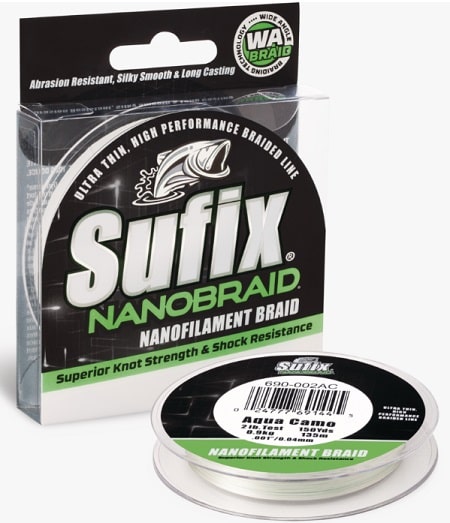
Braiding lines are a great choice when fishing with lures because they are very thin while being double or triple the strength of mono or fluorocarbon lines.
Thinner braided lines get the lure down faster, the hook sets are solid due to no stretch, and braided lines can often cast farther.
Sufix Nanobraid fishing line is a good option for trout fishing with lures. It is super strong, thin, and is silky smooth for long casts.
The downside to braided lines is that the fish may see the line if you tie it directly to the lure, so you might require an 18-inch to 36-inch section of 8 to 12-pound fluorocarbon leader. I use a leader all the time.
Leaders – Do You Need Them?
A leader is simply an added section of line that goes on the end of the fishing line. This is where you tie on your bait or lure and it is a good idea.
When it comes to trout fishing, wire leaders are bad! Anytime I see an angler with a wire leader on while fishing for trout I know that guy has very little chance of catching any sizable trout unless he’s using a fast lure.
Leaders for trout fishing are primarily made from Fluorocarbon. The purpose of a leader is to hide the thicker mainline from fish’s sight and/or to help with abrasion from rocks or wood.
The leader can be the same size as the mainline that you are using or it can be slightly lighter. Almost never will my leader be stronger than my mainline.
I almost always use a leader when fishing for trout in rivers and lakes.
Best Lines For Different Types Of Reels
Some fishing lines work better on different types of reels than others but the truth is you should put whatever line on your reel that suits your situation.
Spinning reels work best well when spooled with monofilament lines however if left on too long and not used the mono can have bad line memory and therefore line twist.
Braided line, and Copolymer lines also work well on spinning reels.
Few fluorocarbon lines work well on spinning reels and bad fluorocarbon lines can cause all kinds of problems on spinning reels so stick with the ones I recommend.
Baitcasting reels work well with almost all types of lines including fluorocarbon lines.
Best Line For Centerpin Reels
The two best lines for Centerpin reels are mono like the Raven Mainline mentioned above or braided line like Power Pro.
I never use fluorocarbon lines on a Centerpin reel because they are heavy and they sink which causes all kinds of problems with mending and hook sets. See my page on the best lines for Centerpin fishing where I list all my tested and proven lines.
The Best Fishing Line For Trout In Rivers
There’s a reason why the best trout line is different for river fishing versus lake fishing is because of the different methods used and because of all the rocks and logs found in many rivers.
The best fishing line for trout in rivers will depend on the method that you are using but if I was to choose only one type of fishing line it would be a good quality monofilament line that is great with all methods of river fishing.
What Is The Best Fishing Line For Trout In Clear Water
The best line in clear water is the fluorocarbon line. However, You can have clear water in both lakes and rivers and to be honest with you, there are other factors listed above that will determine the best line in clear water and I would recommend sticking to those reasons.
As an example, in clear water lakes when trolling, the best line is braid, but only if you use a long fluorocarbon leader.
But in any water with lots of wood, sunken trees, or sharp rocks, the best line would be fluorocarbon.
When float fishing in clear water, mono is still the best line to use, just make sure you also have a good fluorocarbon leader.
What Is The Best Fishing Line For Trout In Dirty Water
You will often see the water of a trout river get dirty after a rain. So what is the best line for trout in dirty water?
Since having a stealthy line is not an issue, the real answer is any line will work in dirty water but the line you should use depends on the method you are using and if it’s rocky and wooded or not. See Trout Fishing After Rain – Expert Guide Tactics And Tips.
What Is The Best Line For Trolling For Trout?
You could use any of the lines mentioned above for trolling for trout. Most anglers still use monofilament when trolling for trout, and that is ok, but Fluorocarbon and braided lines are often the better lines for trolling for trout.
The extra thin diameter on the braided lines will help get your lures deeper and provide you with a more solid hook set with zero stretch. For this reason, braided lines are the best lines for trolling for trout.
However, braided lines are more visible to the trout so always add a 2 to 6-foot fluorocarbon leader to them.
A fluorocarbon line is also a good option due to less stretch and is more invisible to the fish.
Does Line Color Matter?
The simple answer is yes, the color of your fishing line does matter simply because some colors can be seen by the fish easier than other colors. I recommend that the section of the line that is nearest to the bait or lure should be clear or green or that you use a clear floruocarbon leader.
The line near the bait should not be yellow, orange, or colored at all.
However, if you have read my articles on float fishing you will see that I do recommend bright colored lines, in fact, that is mostly what I use when guiding and fishing but I always use a 3 to 5 foot or longer fluorocarbon leader.
The reason I use colored lines is that colored lines provide anglers with the advantage of being able to see the line out of the water which helps the angler get a better presentation.
I also use a 3 to 4-foot-long fluorocarbon leader if I’m using brightly colored lines when casting lures for trout or steelhead, or when bottom bouncing. I simply attach the leader to the line using a Triple Surgeons know, Double Uni Knot, A Tippet ring, or a micro swivel.
Is Copolymer Line Good For Trout Fishing?
The copolymer line is very similar to monofilament except that the advantage to copolymer lines is better breaking strength, better knot strength, and less line stretch.
Copolymer lines tend to sink more which is a disadvantage for anglers that want to float fish. Some copolymer lines are less supple, and copolymer lines are often more expensive. For these reasons, I don’t use copolymer lines.
Best Fishing Line For Trout Conclusion
I hope this article on the best fishing line for trout was helpful. If you have any comments, tips or questions let me know in the comments section below.
Tight Lines,
Graham
